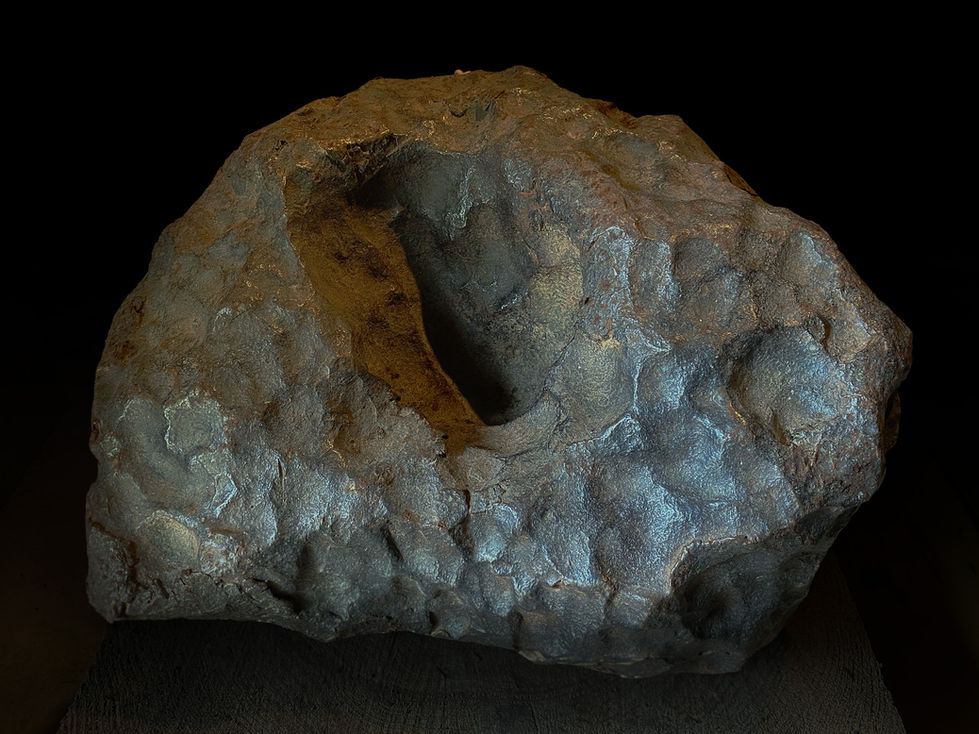

Konronsha Collection > Meteorite Collection
Meteorite Collection
From meteorites weighing up to 300 kg to fine jewelry, we house a collection of several hundred pieces.
Types and Origins of Meteorites Meteorites are fragments of asteroids or comets that drift through space and are captured by Earth’s gravity. If they survive the intense heat generated during atmospheric entry without burning up completely, they reach the surface and are called meteorites. These materials originated about 4.6 billion years ago, during the formation of the solar system, and they provide invaluable clues to the history of Earth and the origins of life. It is estimated that more than 100 tons of extraterrestrial material falls onto Earth every day. The vast majority consists of microscopic particles that disintegrate upon entering the atmosphere. What we see as “shooting stars” are in fact small meteorites burning up in the sky. Meteorites are broadly classified into three categories: Stony meteorites: The most common, resembling terrestrial rock. Iron meteorites: Composed mainly of iron and nickel, with a metallic luster. Stony-iron meteorites: Containing a mixture of both rocky and metallic components. Among these, iron meteorites have been regarded as exceptional since antiquity, valued for crafting swords, ornaments, and ritual implements. The meteorites preserved at Konronsha also belong to this category of iron meteorites. Ancient Uses of Meteoric Iron Approximately 4,300 years ago, a royal tomb at the Alaca Höyük site in present-day Turkey yielded what is considered the world’s oldest iron sword. Its blade contained nickel, an element absent from terrestrial ores, revealing that it was forged from meteoritic iron. Thus, the weapon that protected the king was not drawn from the earth, but bestowed from the heavens. In ancient Egypt, one of the daggers placed in the tomb of Pharaoh Tutankhamun was likewise shown to be made of meteoritic iron. Furthermore, archaeological finds from sites in Turkey and Greece include ritual daggers and ornaments believed to have been fashioned from this celestial material. In Tibet, protective amulets known as Thogchags were revered, said to be made from iron that had fallen from the sky. The word Thogcha means “lightning strike,” reflecting a tradition that such amulets were gifts from the thunder god. Meteoric Iron in Japan In Japan, Enomoto Takeaki, a samurai of the late Edo period who later served as Minister of Foreign Affairs in the Meiji government, commissioned the forging of swords from meteoritic iron. After acquiring the Shirahagi meteorite discovered in Toyama Prefecture in 1890, Enomoto engaged the renowned swordsmith Okagishi Kunimune to produce five swords. Among them, the finest long sword, known as the “Ryūseitō” (Meteor Sword), was presented to the Crown Prince, later Emperor Taishō. This is regarded as the earliest example in Japan of meteoritic iron being employed as a cultural artifact. In more recent times, swordsmith Okishiba Nobushige forged blades from meteoritic iron, which were introduced in newspapers and magazines as “swords forged from iron fallen from the cosmos.” Today, Konronsha also preserves swords crafted from meteoritic iron. Celestial Metal ― A Symbol of Protection and Prayer The iron sword that protected a king, Tutankhamun’s dagger, the Tibetan Thogcha, and Japan’s Meteor Sword — all were born of “celestial metal.” These objects are not merely artifacts; they are fragments of the stars, vessels of cosmic memory, and at times spiritual instruments embodying protection and prayer. Meteorites, in striking the Earth, have been regarded as bearers of the seeds of life to our planet. Across time and cultures, meteoritic iron has endured as a profound symbol of protection and devotion, linking humanity with the heavens. Reference: “Cultural Meteorites,” Kyoto University Museum, 2024 Special Exhibition: “Letters from the Cosmos: From the Discovery of Meteorites to the Exploration by Hayabusa2”

Moldavite
Origin Approximately 14.7 million years ago, a giant meteorite collided with the Earth at what is now Nördlinger Ries in Germany. The immense heat and pressure generated by the impact melted the surface silica, which was ejected into the atmosphere and fell over the surrounding region. As it cooled rapidly upon descent, a natural glass was formed — known today as Moldavite. Classified as a type of tektite, Moldavite is a rare terrestrial glass created by a meteorite impact. Its vivid green color and extraterrestrial origin lend it an enduring sense of mystery and fascination. Locality Moldavite is found primarily in southern regions of the Czech Republic, particularly in Bohemia and Moravia. Specimens in the Konrinsha collection are accompanied by certificates (in Czech and English) verifying their provenance from the České Budějovice area in South Bohemia. Characteristics Color: Varies from deep forest green to bright bottle green. Surface: Exhibits characteristic natural etching patterns formed during cooling. Inclusions: Rare specimens may contain gas bubbles or fluid inclusions. Angel Chime: A particularly uncommon variety of Moldavite that produces a clear, bell-like tone when thin pieces are gently struck together. This phenomenon, known as the “Angel’s Chime,” adds to the stone’s aura of mystery and is highly valued among collectors. Legends and Symbolism Since ancient times, Moldavite has been revered throughout Europe as a stone of transformation and protection. According to legend, the Holy Grail of King Arthur was fashioned from Moldavite. Whether fact or myth, such stories reflect the deep sense of wonder that this extraordinary glass has inspired for centuries.








